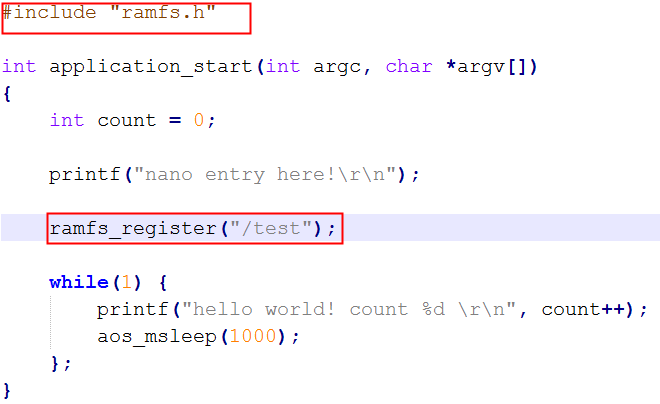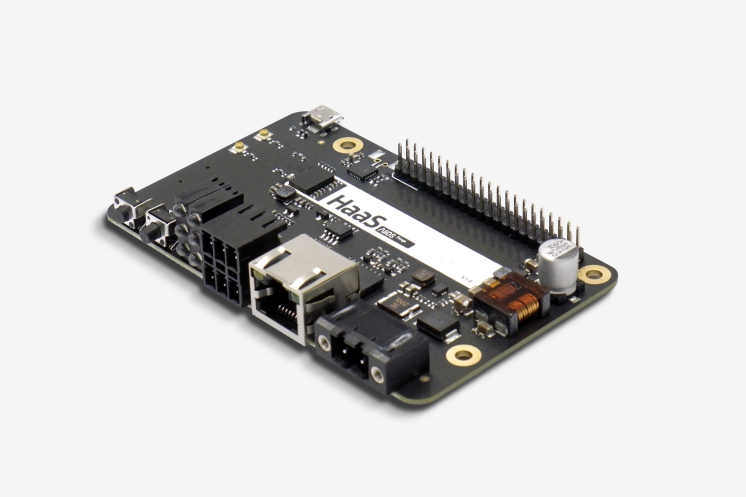案例介紹
helloworld_demo是我們提供的最簡化的運行實例,該app從字面上來看功能也比較簡單,即完成hello world!的關鍵字符輸出,以表明系統初始化完成并能夠正常輸出。但是雖然功能看似簡單單一,該app能夠運行成功,即代碼內核小系統以及基本的打印輸出功能即正常運行。其完成的主要功能包括:
系統板級初始化
內核基礎組件初始化
application_start用戶入口
串口打印輸出
循環睡眠打印該示例的運行依賴下述基本功能完成對接:
uart串口
內核的任務和中斷運行正常
系統tick定時器正常運行即helloworld_demo這個示例運行,代碼系統的任務調度、tick調度以及串口打印功能已經OK。
基礎知識
2.1 基礎目錄結構
.
├── helloworld.c # 該solution核心打印輸出代碼,入口**application_start**
├── k_app_config.h # 內核組件的配置開關,優先級低于**k_config.h**
├── maintask.c # 系統主任務入口處理,入口**aos_maintask**
├── Makefile # aos make編譯時入口
├── package.yaml # 編譯系統配置文件
└── SConstruct # Makefile => Scon => aostools2.2 基本規范
solution統一以aos_maintask作為入口函數,從具體單板的C入口main函數開始,通過創建一個主任務來執行,即aos_maintask是系統主任務的入口函數:
static void aos_main_task_entry(void)
{
......
aos_maintask();
}
/* main一般為單板的C程序入口 */
int main(void)
{
......
krhino_task_dyn_create(&g_main_task, "main_task", 0, OS_MAIN_TASK_PRI, 0, OS_MAIN_TASK_STACK, (task_entry_t)aos_main_task_entry, 1);
while (1) {
krhino_task_sleep(100);
}
}aos_maintask內實現包括板級初始化board_init、基礎組件初始化aos_components_init、以及app入口application_start
/* For user config
kinit.argc = 0;
kinit.argv = NULL;
kinit.cli_enable = 1;
*/
static kinit_t kinit = {0, NULL, 1};
void board_init(void)
{
board_tick_init(); // tick板級初始化,實現在具體board目錄內
board_stduart_init(); // uart串口初始化,實現在具體board目錄內
board_dma_init(); // 如果使用dma相關初始化,沒有置空
board_gpio_init(); // gpio的時鐘等初始化,沒有可置空
}
void aos_maintask(void* arg)
{
board_init();
board_kinit_init(&kinit); // 給系統參數賦值,可使用默認值
aos_components_init(&kinit); // 系統基礎組件的初始化
#ifndef AOS_BINS
application_start(kinit.argc, kinit.argv); // app的實際實現入口
#endif
}其中為了統一不同單板的板級初始化,新增單板需要統一支持board_init內各板級模塊初始化,如果沒有相關函數可以實現為空;對于helloworld功能比較簡單,一般需要tick和uart的初始化即可;而對于復雜的app,即需要初始化的模塊則按照實際情況來增加,對應實現在具體board中添加,如:
void board_stduart_init(void)
void board_tick_init(void)
void board_flash_init(void)
void board_network_init(void)
void board_gpio_init(void)
void board_wdg_init(void)
void board_ota_init(void)
void board_dma_init(void)對于aos_components_init,其完成了一些基礎組件如vfs、cli、kv等基礎中間件的初始化,并通過組件宏開關,一旦相應該基礎組件模塊被加入編譯,則aos_components_init即進行相關模塊的初始化。application_start是實際solution的實現,即app的統一入口。
2.3 基本運行流程

3. 物料清單
4. 案例實現
4.1 硬件連接
該案例只需要連接電源線以及串口線,如下圖所示:

4.2 軟件實現
application_start實際app入口內實現較簡單,主要包括:
基本的串口打印
while循環睡眠10S打印計數代碼如下:
int application_start(int argc, char *argv[])
{
int count = 0;
printf("nano entry here!\r\n");
while(1) {
printf("hello world! count %d \r\n", count++);
aos_msleep(10000);
};
}其中系統能夠正常打印代表uart功能正常;能夠循環1S打印代表tick中斷以及任務切換功能正常。
4.3 編譯下載
開發環境的搭建請參考《AliOS Things集成開發環境使用說明之搭建開發環境》,其中詳細的介紹了AliOS Things 3.3的IDE集成開發環境的搭建流程。
helloworld_demo的代碼下載請參考《AliOS Things集成開發環境使用說明之創建工程》,
> 選擇解決方案:“helloworld簡單示例”
> 選擇開發板:Haas100 board configure
-- 編譯固件可參考《AliOS Things集成開發環境使用說明之編譯固件》。
-- 燒錄固件可參考《AliOS Things集成開發環境使用說明之燒錄固件》。
4.4 串口輸出效果
Welcome to AliOS Things
nano entry here!
hello world! count 0
hello world! count 1
hello world! count 2
hello world! count 3
hello world! count 4
hello world! count 5
hello world! count 65 添加新組件
helloworld_demo作為一個基礎組件,其本身依賴的組件相對較少,主要包括內核基礎代碼、cli以及單板和mcu相關的組件。用戶可以基于此solution作為參考,來開發屬于自己的app。如期望在helloworld_demo中增加ramfs文件系統的組件功能,操作步驟如下:
5.1 YAML增加組件
在helloworld_demo的YAML文件中添加組件依賴ramfs。由于需要使用標準vfs接口,因此還需要加上vfs組件。
depends:
- ramfs: master
- vfs: master至于ramfs本身依賴的組件,則在ramfs自身的YAML中需要添加完全。
在helloworld_demo的app入口helloworld.c中添加ramfs頭文件引用以及初始化函數調用,如下圖,先注冊一個根目錄為/test的ramfs:

添加功能調用示例:
#include <fcntl.h>
#include <sys/types.h>
#include <unistd.h>
#include "ramfs.h"
int fd;
int ret;
char teststring = "1234";
char readbuf[10];
ramfs_register("/test");
fd = open("/test/file1", O_RDWR);
if(fd < 0){
printf("ramfs open fail!\r\n");
return fd;
}
ret = write(fd, teststring, 5);
if(ret < 0){
printf("ramfs write fail!\r\n");
return ret;
}
lseek(fd, 0, SEEK_SET);
ret = read(fd, readbuf, 5);
if(ret < 0){
printf("ramfs read fail!\r\n");
return ret;
}
if(strncmp(readbuf, teststring, 5)){
printf("ramfs test fail! readbuf:%s\r\n",readbuf);
}else{
printf("ramfs test success!\r\n");
}
ramfs_unregister("/test");由于使用了標準文件系統的O_RDWR相關定義,需要包含#include "fcntl.h"。
編譯、運行
aos make helloworld_demo@haas100 -c config
aos make運行效果:
Welcome to AliOS Things
nano entry here!
ramfs test success!
hello world! count 0
hello world! count 1
hello world! count 2
hello world! count 36. 總結
helloworld_demo雖然代碼較少,但是其完成了一個最小系統需要的基本功能,包括:內核啟動、任務切換、tick中斷,以及串口輸出。一般作為單板移植的基本solution來參考對接;同時,還可以此solution為基礎,開始添加用戶需要的其他組件,并定制修改自身需要的APP。
